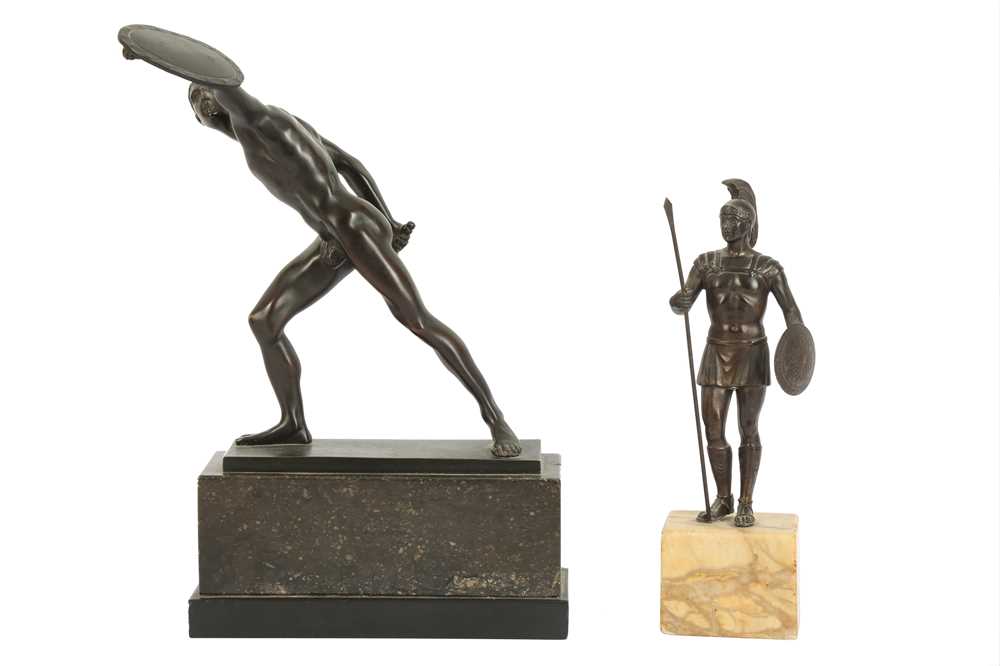A Greek bronze hoplite shield appliqué of a boar Possibly Sparta, circa 7th-6th Century B.C. Of slightly convex form, in the shape of a full-length standing boar, in profile to the left, the small tail raised, the eye and ear modelled in shallow relief, with incised naturalistic details including the ear, eye, eyelashes, eyebrow, tusk and snout, the fur of the ridge and around the head also indicated, 73cm long Fußnoten Provenance: Dr Eugene Alexander collection, Munich, acquired from a Munich gallery in 1989. with Apolonia Ancient Art, Denver, acquired from the above in September 2018. Once riveted to a hoplite shield, this appliqué would have covered nearly its full length, as hoplite shields had an average diameter of 90cm in this period. Greek 'full-size' hoplite shield appliqués of all types are extremely rare. Moreover, there is only one known surviving example of a 'forepart' type boar appliqué, in the Metropolitan Museum, New York, acc. no. 2002.200, and no other 'full-size' examples of this subject. This appliqué is likely Spartan, as the black wild boar was used as a shield device by the Mora, elite Spartan troops. Pausanias (15.8) records a series of battles between Spartans and Messenians between c. 684-681 B.C. in Stenykleros, where Herakles was believed to have exchanged oaths with the Sons of Neleus over a sacrificed wild boar. The victorious Spartans, having conquered the Messenians, subsequently adopted the standing boar as a shield device. Excavations of the shrine of Artemis Orthia at Sparta by the British Archaeological School from 1906-1910 uncovered a number of lead seals, now thought to represent shield devices, one of which is similarly illustrated with a full-length standing boar. The incised decoration of this appliqué suggest that it once formed part of an important set of armour. The puncture and slash marks, primarily on the centre-left of the appliqué, indicate the piece was used in battle, and suggest the warrior faced an enemy holding a weapon in his right hand. Its survival is perhaps due to being captured in battle as a spoil of war and dedicated as an offering.
A Greek bronze hoplite shield appliqué of a boar Possibly Sparta, circa 7th-6th Century B.C. Of slightly convex form, in the shape of a full-length standing boar, in profile to the left, the small tail raised, the eye and ear modelled in shallow relief, with incised naturalistic details including the ear, eye, eyelashes, eyebrow, tusk and snout, the fur of the ridge and around the head also indicated, 73cm long Fußnoten Provenance: Dr Eugene Alexander collection, Munich, acquired from a Munich gallery in 1989. with Apolonia Ancient Art, Denver, acquired from the above in September 2018. Once riveted to a hoplite shield, this appliqué would have covered nearly its full length, as hoplite shields had an average diameter of 90cm in this period. Greek 'full-size' hoplite shield appliqués of all types are extremely rare. Moreover, there is only one known surviving example of a 'forepart' type boar appliqué, in the Metropolitan Museum, New York, acc. no. 2002.200, and no other 'full-size' examples of this subject. This appliqué is likely Spartan, as the black wild boar was used as a shield device by the Mora, elite Spartan troops. Pausanias (15.8) records a series of battles between Spartans and Messenians between c. 684-681 B.C. in Stenykleros, where Herakles was believed to have exchanged oaths with the Sons of Neleus over a sacrificed wild boar. The victorious Spartans, having conquered the Messenians, subsequently adopted the standing boar as a shield device. Excavations of the shrine of Artemis Orthia at Sparta by the British Archaeological School from 1906-1910 uncovered a number of lead seals, now thought to represent shield devices, one of which is similarly illustrated with a full-length standing boar. The incised decoration of this appliqué suggest that it once formed part of an important set of armour. The puncture and slash marks, primarily on the centre-left of the appliqué, indicate the piece was used in battle, and suggest the warrior faced an enemy holding a weapon in his right hand. Its survival is perhaps due to being captured in battle as a spoil of war and dedicated as an offering.








Testen Sie LotSearch und seine Premium-Features 7 Tage - ohne Kosten!
Lassen Sie sich automatisch über neue Objekte in kommenden Auktionen benachrichtigen.
Suchauftrag anlegen